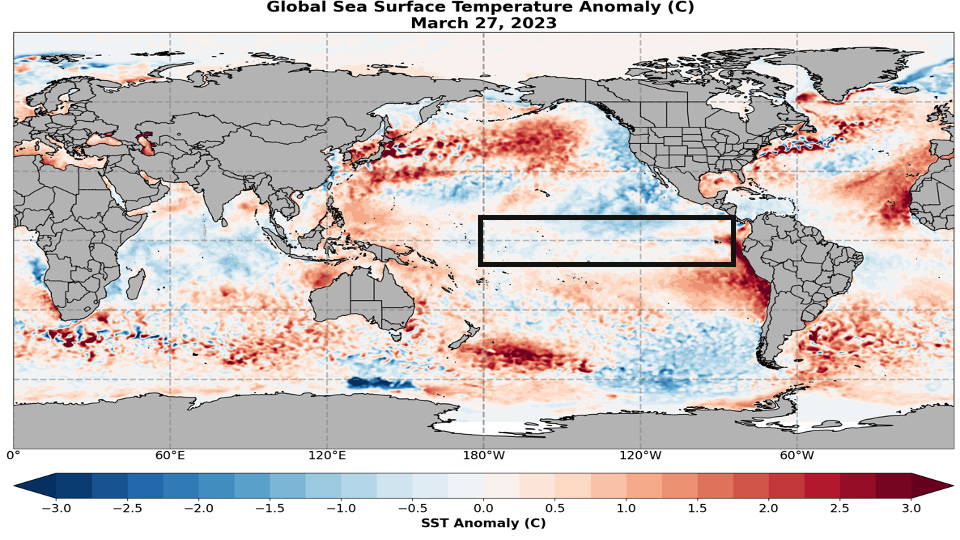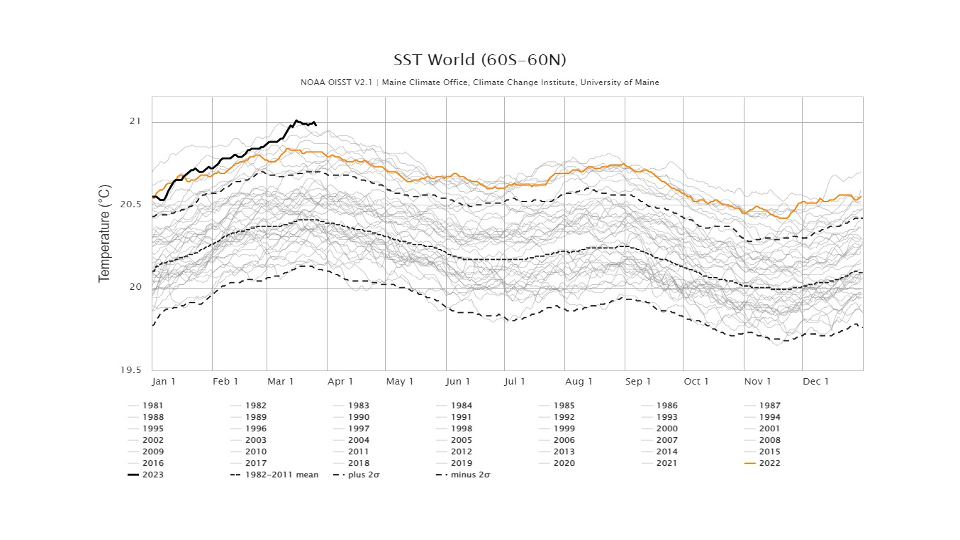In the meteorological and climate world, one of the main focuses in the upcoming months will be water temperatures in the Equatorial Pacific Ocean. The temperatures and their anomalies in this region are commonly called El Niño (water temperatures warmer than normal) and La Niña (water temperatures colder than normal). Fluctuations between those two events have the largest impact on global weather and supply networks, and this year are likely to cause significant economic losses from rising heat.
Rising ocean temperatures
For the last several years, a La Niña event has been in place as the waters have been consistently cooler than normal. However, La Niña is ending, and we expect to transition to an El Niño later this year. Currently water temperatures are near normal (but warming) and can be seen in Fig. 1 (black box).
While La Niña and El Niño cause significant impacts on global weather patterns, here we focus specifically on global sea surface temperatures (SSTs) and their implications for extreme weather events – including increased chances for record heat this summer.

Figure 1: Global SST anomalies March 27, 2023 (source: OiSST V2.1).
Global SSTs are currently at their record warmest dating back to the early 1980s, which can be seen in Fig. 2. These record warm SSTs are driven by widescale warmth across many of the ocean basins, but there are specific regions driving the record warmth.
The Atlantic currently has warmer than normal SSTs through the entire basin. The Gulf of Mexico, East Coast of North America, and the west coast of Africa feature well above normal water temperatures. The North Pacific and the Maritime Continent regions of Indonesia and Malaysia also feature distinctly warmer than normal SSTs.
Record heat is on the way
With warmer SSTs already in place in these areas, the onset of El Niño in the next few months will warm SSTs across the Equatorial Pacific. In a typical El Niño scenario, water temperatures will reach their warmest point around the middle of the Northern Hemisphere winter.
Why are these record warm global SSTs important? Heat in the global oceans is linked to increased extreme weather events and subsequent economic loss from ensuing natural disasters. As a result, it is becoming more likely that in early 2024 we could once again see record high (even higher than this year) SSTs.

Figure 2: Global SSTs (C) averaged over 60S-60N latitude from 1981-current (source: OISST V2.1).
In fact, we are already seeing this trend unfold. The number of extreme weather events nearly doubled during the decade of 2000-2019 as compared to the proceeding 20 years. Further, inflation-adjusted economic loss due to the increase in extreme weather has also nearly doubled.
Heat-related economic losses
Ocean temperatures can have a profound effect on temperatures over land, especially along the coast where many major population centers are found. Warmer ocean temperatures can lead to higher humidity levels and increased nighttime temperatures, which increases stress on humans and power grids during the summer.
This increased stress on the electricity grid is especially impactful in regions of large population and areas with degrading infrastructure. One recent example of this is across Texas, where several rolling blackout periods were required just last summer to prevent overuse of the electrical grid.
Warmer ocean waters also drive more moisture evaporation into the atmosphere. The increased atmospheric moisture can lead to more heavy rainfall and flooding events, more violent severe weather across portions of the US, more rapidly strengthening tropical cyclones, and in general a higher risk of heat/drought globally.
In addition to the weather impacts, more moisture in the atmosphere also has implications for the climate. Climate coverage often centers on CO2 gases, but water vapor is one of the most efficient greenhouse gases; much more efficient than CO2. As global temperatures rise, so does the atmosphere’s ability to hold water vapor, and the additional water vapor in the atmosphere intensifies the greenhouse effect, further warming the planet.
All in all, we expect the record warm global SSTs to have wide-reaching impacts ranging from daily weather changes to those on the long-term climate time scale.